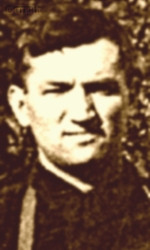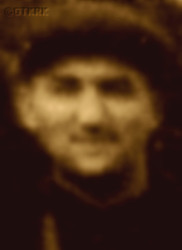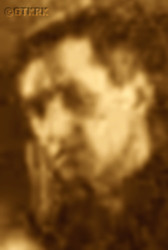Roman Catholic
St Sigismund parish
05-507 Słomczyn
85 Wiślana Str.
Konstancin deanery
Warsaw archdiocese, Poland
full list:
displayClick to display full list

searchClick to search full list by categories
wyświetlKliknij by wyświetlić pełną listę po polsku

szukajKliknij by przeszukać listę wg kategorii po polsku

Martyrology of the clergy — Poland
XX century (1914 – 1989)
personal data
surname
MAJEWSKI
forename(s)
Steven (pl. Stefan)

function
diocesan seminarian
creed
Latin (Roman Catholic) Church RCmore on
en.wikipedia.org
[access: 2014.09.21]
diocese / province
Cracow archdiocesemore on
en.wikipedia.org
[access: 2013.05.19]
Łomża diocesemore on
www.kuria.lomza.pl
[access: 2012.11.23]
date and place
of death
18.01.1951

Warsawtoday: Warsaw city pov., Masovia voiv., Poland
more on
en.wikipedia.org
[access: 2021.10.09]
details of death
After completion of 3rd year of thelogical studies in Łomża during holidays was helping parish priest of Kurowo (Sierpc county) where his family originated from.
After German and Russian invasion of Poland in 09.1939 and start of the World War II unable to resume his studies — Łomża, where was studying at the Theological Seminary, was handed over by the victorious Germans to the Russian occupier, in accordance with the Russo–German treaty, while Kurowo found itself under German occupation — joined in 1941 the ranks of Polish clandestine resistance National Military Organisation NOW and next from 1943 Home Army AK (part of Polish Clandestine State), under nom‐de‐guerre „Gregory”, „Stephen”, „Excellency”.
Polish government delegate for Sierpc county (1943‐1944).
Took part in actions aiming at elimination of Russian communist infiltration in Poland.
After commencement of Russian occupation in 1944 continued as a soldier of clandestine resistance National Military Union NZW army.
Member of the 23rd NZW Region Masovia HQ leadership — head of Information and Propaganda unit.
Editor of resistance „Masovian Information Bulletin”.
In the summer of 1947 returned to Theological Seminary, this time in Kraków.
Arrested in Kraków by the Commie‐Nazi UB unit, Polish branch of Russian NKVD.
Jailed in Mokotów prison in Warsaw.
For one and a half years constantly interrogated and tortured.
Tried on 10.06‐03.07.1950.
Accused of „belonging to an illegal NSZ organisation from 16 January 1945 to 11 October 1948 […] aimed at the violent overthrow of the current system in Poland and serving as head of information and propaganda in the 11th Operational Group at the 23rd NSZ District in the following counties: Płock, Sierpc, Płońsk, Rypin, Lipno and Włocławek”.
Received by the Commie‐Nazis,together with a few colleagues from NZW army, six death sentences.
Murdered in Mokotów prison in Warsaw.
Body dumped in an unknown ditch.
cause of death
mass murder
perpetrators
Russians / Poles
sites and events
Warsaw (Mokotów)Click to display the description, Ribbentrop‐MolotovClick to display the description, Pius XI's encyclicalsClick to display the description
date and place
of birth
27.01.1910Birth certification on:
metryki.genealodzy.pl
[access: 2025.04.13]

Warsawtoday: Warsaw city pov., Masovia voiv., Poland
more on
en.wikipedia.org
[access: 2021.10.09]
parents
MAJEWSKI Francis
🞲 ?, ? — 🕆 ?, ?

OLKOWICZ Eugenia
🞲 ?, ? — 🕆 ?, ?
baptism
29.01.1910Birth certification on:
metryki.genealodzy.pl
[access: 2025.04.13]

Warsawregion known as „Leszno” (around Leszno Str.)
today: Warsaw city pov., Masovia voiv., Poland
more on
en.wikipedia.org
[access: 2021.10.09]
Nativity of the Blessed Virgin Mary RC church
positions held
1947 – 1948
student — Krakówtoday: Kraków city pov., Lesser Poland voiv., Poland
more on
en.wikipedia.org
[access: 2021.06.07] ⋄ philosophy and theology, Theological Seminary ⋄ Kraków RC archdiocese
1937 – 1939
student — Łomżatoday: Łomża city pov., Podlaskie voiv., Poland
more on
en.wikipedia.org
[access: 2022.01.28] ⋄ philosophy and theology, Theological Seminary
sites and events
descriptions
Warsaw (Mokotów): Prison and detention centre in Warsaw on Rakowiecka Str. Used by Germans during German occupation 1939‐1945 to held thousands of Poles. In 1945‐1956 thousands of Polish independence activists were held there by the Polish Commie‐Nazi branch of Russian NKVD/KGB police. Hundreds of Poles were executed. (more on: pl.wikipedia.orgClick to attempt to display webpage
[access: 2013.08.17])
Ribbentrop‐Molotov: Genocidal Russian‐German alliance pact between Russian leader Joseph Stalin and German leader Adolf Hitler signed on 23.08.1939 in Moscow by respective foreign ministers, Mr. Vyacheslav Molotov for Russia and Joachim von Ribbentrop for Germany. The pact sanctioned and was the direct cause of joint Russian and German invasion of Poland and the outbreak of the World War II in 09.1939. In a political sense, the pact was an attempt to restore the status quo ante before 1914, with one exception, namely the „commercial” exchange of the so‐called „Kingdom of Poland”, which in 1914 was part of the Russian Empire, fore Eastern Galicia (today's western Ukraine), in 1914 belonging to the Austro‐Hungarian Empire. Galicia, including Lviv, was to be taken over by the Russians, the „Kingdom of Poland” — under the name of the General Governorate — Germany. The resultant „war was one of the greatest calamities and dramas of humanity in history, for two atheistic and anti‐Christian ideologies — national and international socialism — rejected God and His fifth Decalogue commandment: Thou shall not kill!” (Abp Stanislav Gądecki, 01.09.2019). The decisions taken — backed up by the betrayal of the formal allies of Poland, France and Germany, which on 12.09.1939, at a joint conference in Abbeville, decided not to provide aid to attacked Poland and not to take military action against Germany (a clear breach of treaty obligations with Poland) — were on 28.09.1939 slightly altered and made more precise when a treaty on „German‐Russian boundaries and friendship” was agreed by the same murderous signatories. One of its findings was establishment of spheres of influence in Central and Eastern Europe and in consequence IV partition of Poland. In one of its secret annexes agreed, that: „the Signatories will not tolerate on its respective territories any Polish propaganda that affects the territory of the other Side. On their respective territories they will suppress all such propaganda and inform each other of the measures taken to accomplish it”. The agreements resulted in a series of meeting between two genocidal organization representing both sides — German Gestapo and Russian NKVD when coordination of efforts to exterminate Polish intelligentsia and Polish leading classes (in Germany called «Intelligenzaktion», in Russia took the form of Katyń massacres) where discussed. Resulted in deaths of hundreds of thousands of Polish intelligentsia, including thousands of priests presented here, and tens of millions of ordinary people,. The results of this Russian‐German pact lasted till 1989 and are still in evidence even today. (more on: en.wikipedia.orgClick to attempt to display webpage
[access: 2015.09.30])
Pius XI's encyclicals: Facing the creation of two totalitarian systems in Europe, which seemed to compete with each other, though there were more similarities than contradictions between them, Pope Pius XI issued in 03.1937 (within 5 days) two encyclicals. In the „Mit brennender Sorge” (Eng. „With Burning Concern”) published on 14.03.1938, condemned the national socialism prevailing in Germany. The Pope wrote: „Whoever, following the old Germanic‐pre‐Christian beliefs, puts various impersonal fate in the place of a personal God, denies the wisdom of God and Providence […], whoever exalts earthly values: race or nation, or state, or state system, representatives of state power or other fundamental values of human society, […] and makes them the highest standard of all values, including religious ones, and idolizes them, this one […] is far from true faith in God and from a worldview corresponding to such faith”. On 19.03.1937, published „Divini Redemptoris” (Eng. „Divine Redeemer”), in which criticized Russian communism, dialectical materialism and the class struggle theory. The Pope wrote: „Communism deprives man of freedom, and therefore the spiritual basis of all life norms. It deprives the human person of all his dignity and any moral support with which he could resist the onslaught of blind passions […] This is the new gospel that Bolshevik and godless communism preaches as a message of salvation and redemption of humanity”… Pius XI demanded that the established human law be subjected to the natural law of God , recommended the implementation of the ideal of a Christian state and society, and called on Catholics to resist. Two years later, National Socialist Germany and Communist Russia came together and started World War II. (more on: www.vatican.vaClick to attempt to display webpage
[access: 2023.05.28], www.vatican.vaClick to attempt to display webpage
[access: 2023.05.28])
sources
personal:
www.11go.plClick to attempt to display webpage
[access: 2014.11.28], metryki.genealodzy.plClick to attempt to display webpage
[access: 2025.04.13]
original images:
www.11go.plClick to attempt to display webpage
[access: 2014.11.28], www.info-pc.home.plClick to attempt to display webpage
[access: 2021.12.19], muzeumzolnierzywykletych.plClick to attempt to display webpage
[access: 2018.02.15]
LETTER to CUSTODIAN/ADMINISTRATOR
If you have an Email client on your communicator/computer — such as Mozilla Thunderbird, Windows Mail or Microsoft Outlook, described at WikipediaPatrz:
en.wikipedia.org, among others — try the link below, please:
LETTER to CUSTODIAN/ADMINISTRATORClick and try to call your own Email client
If however you do not run such a client or the above link is not active please send an email to the Custodian/Administrator using your account — in your customary email/correspondence engine — at the following address:

giving the following as the subject:
MARTYROLOGY: MAJEWSKI Steven
To return to the biography press below:
 Click to return to biography
Click to return to biography










